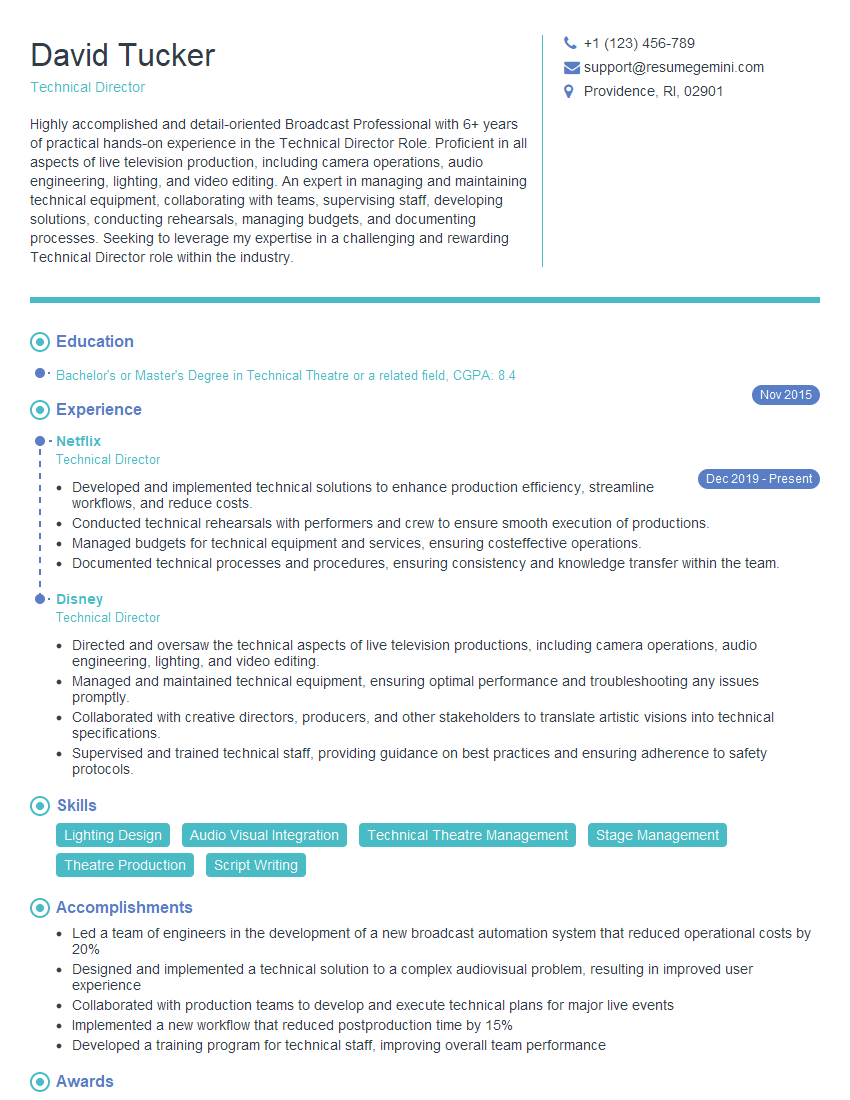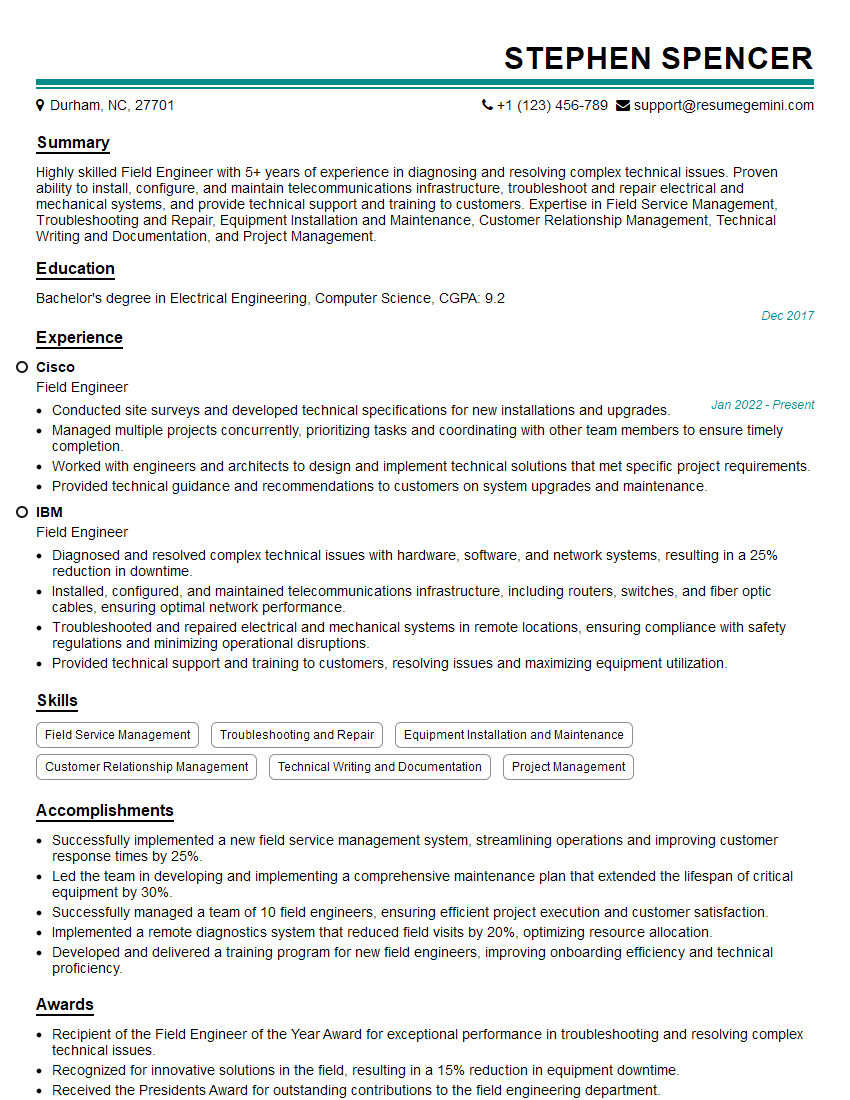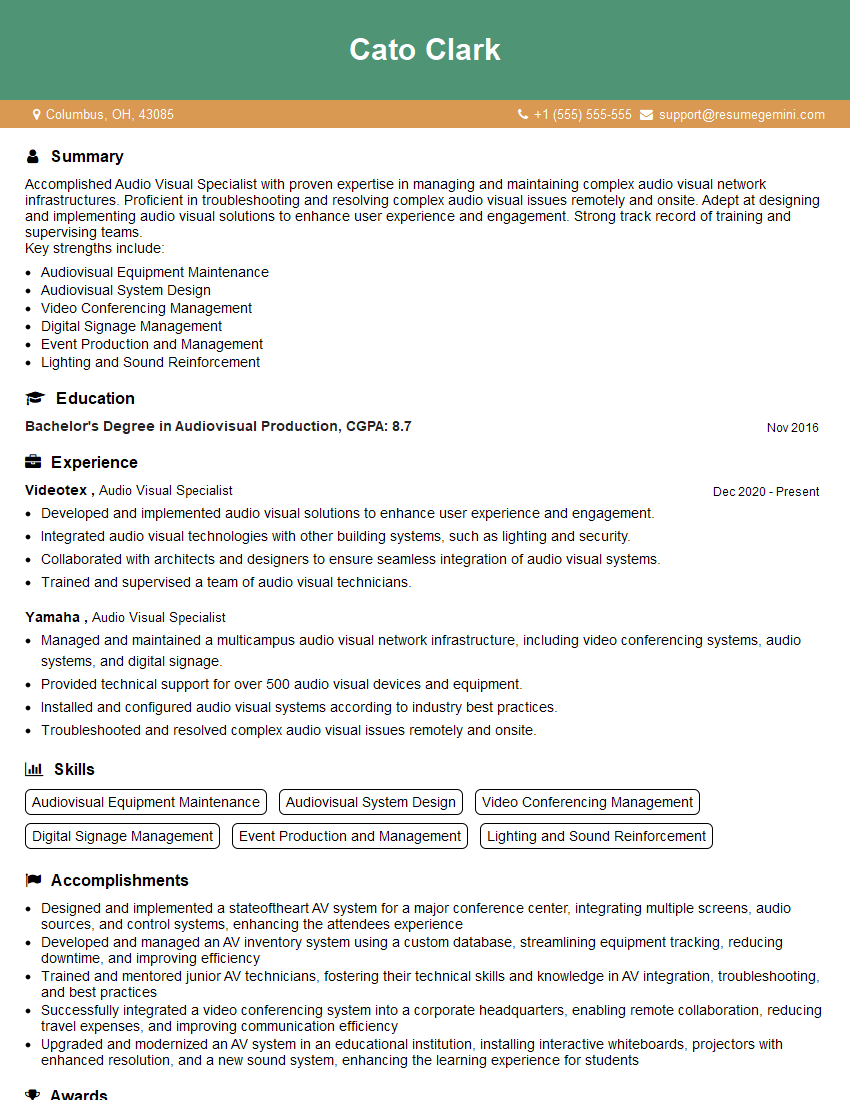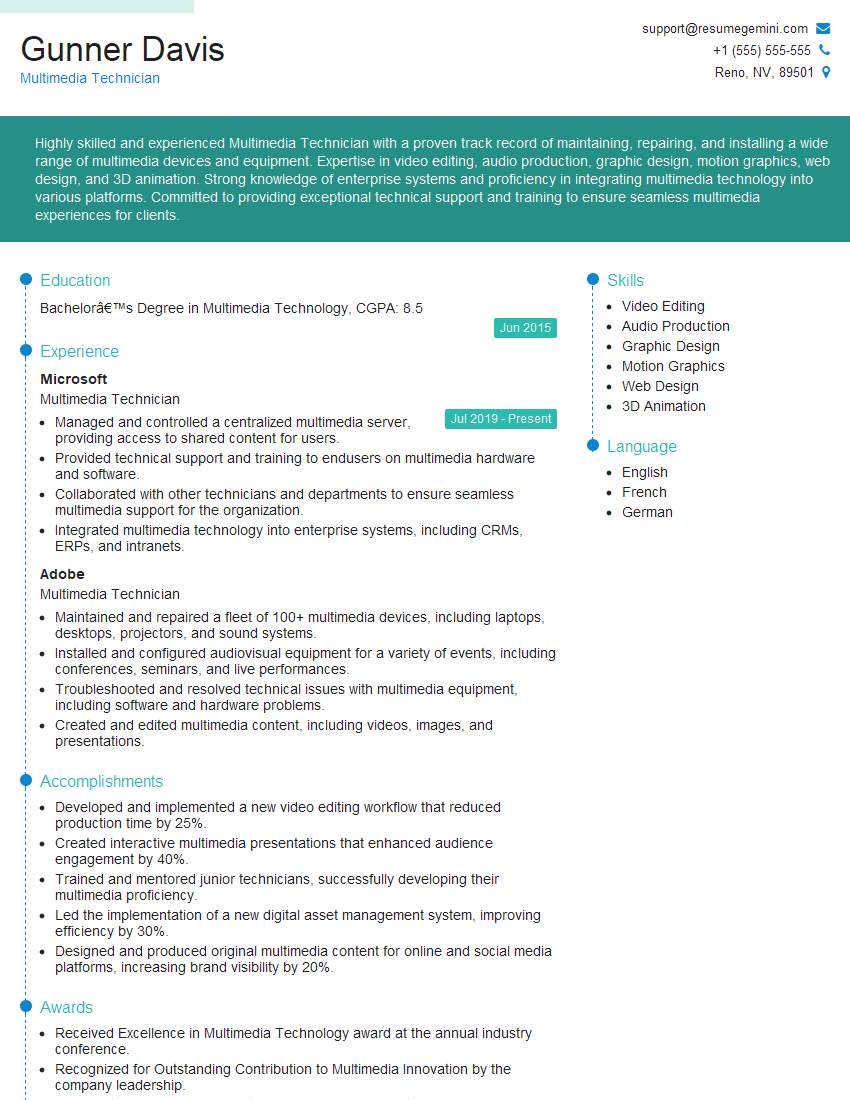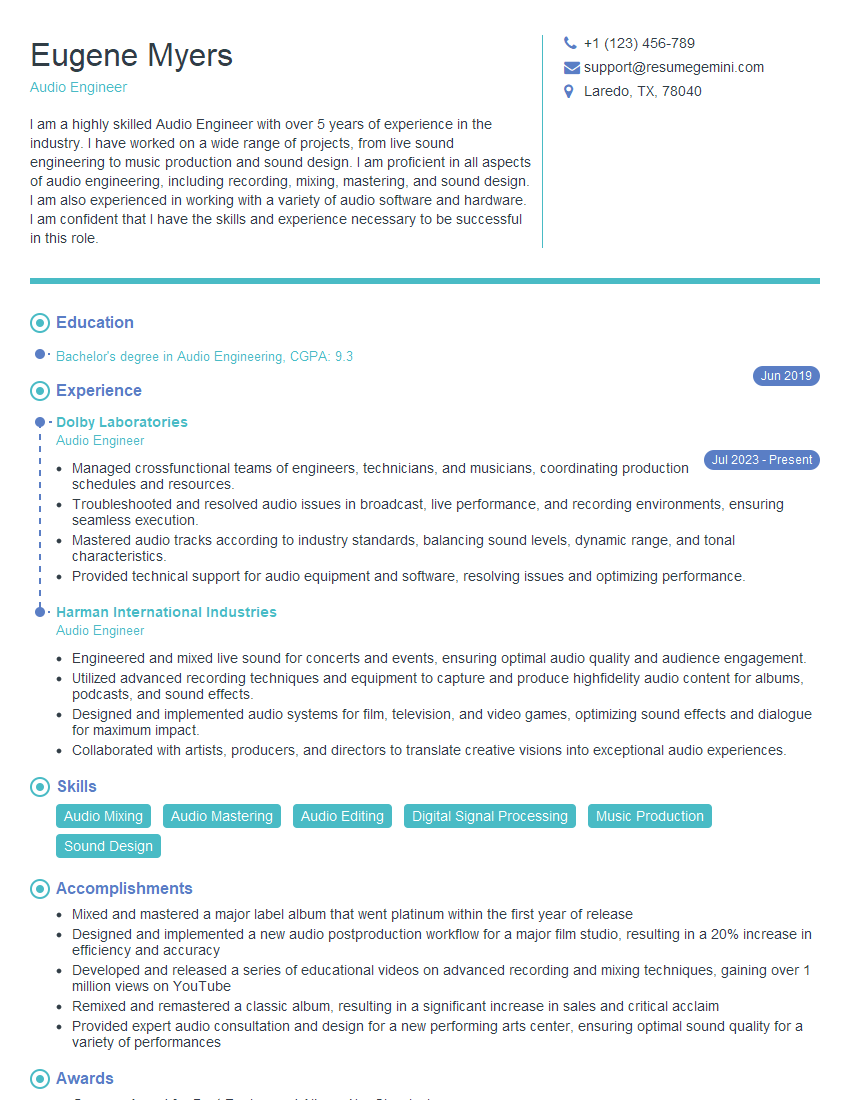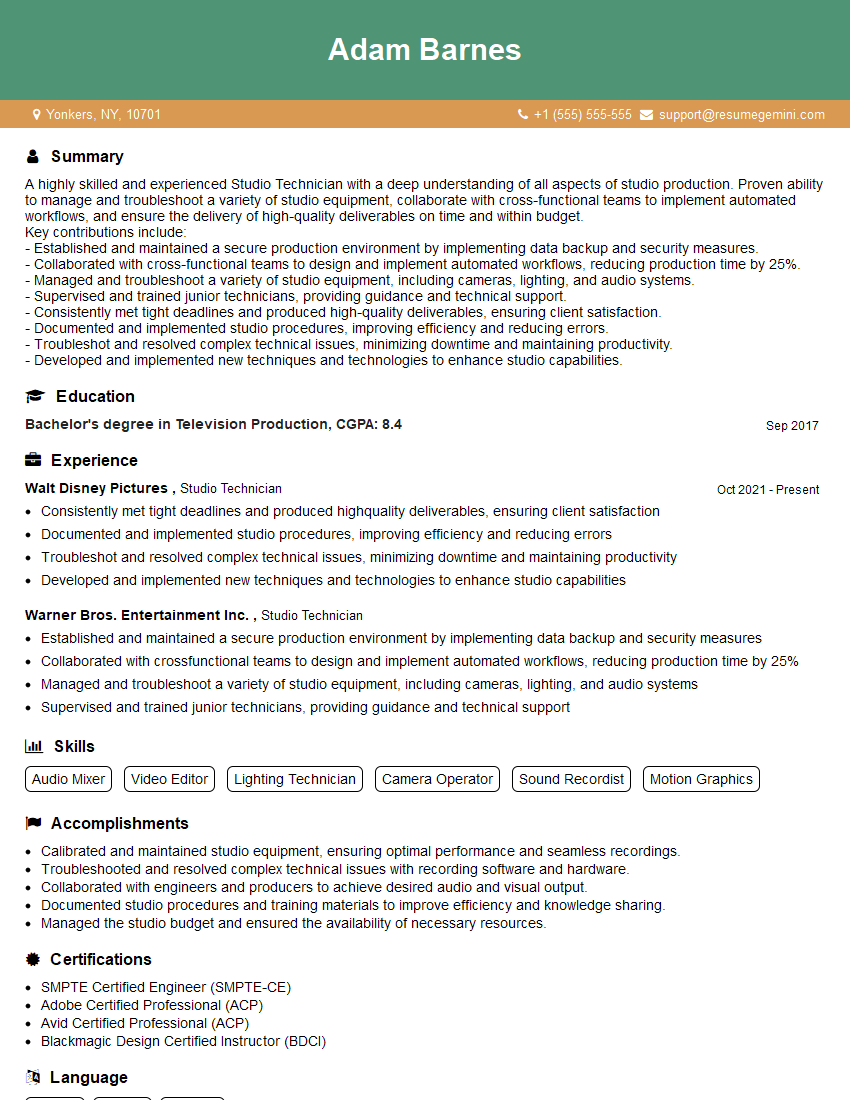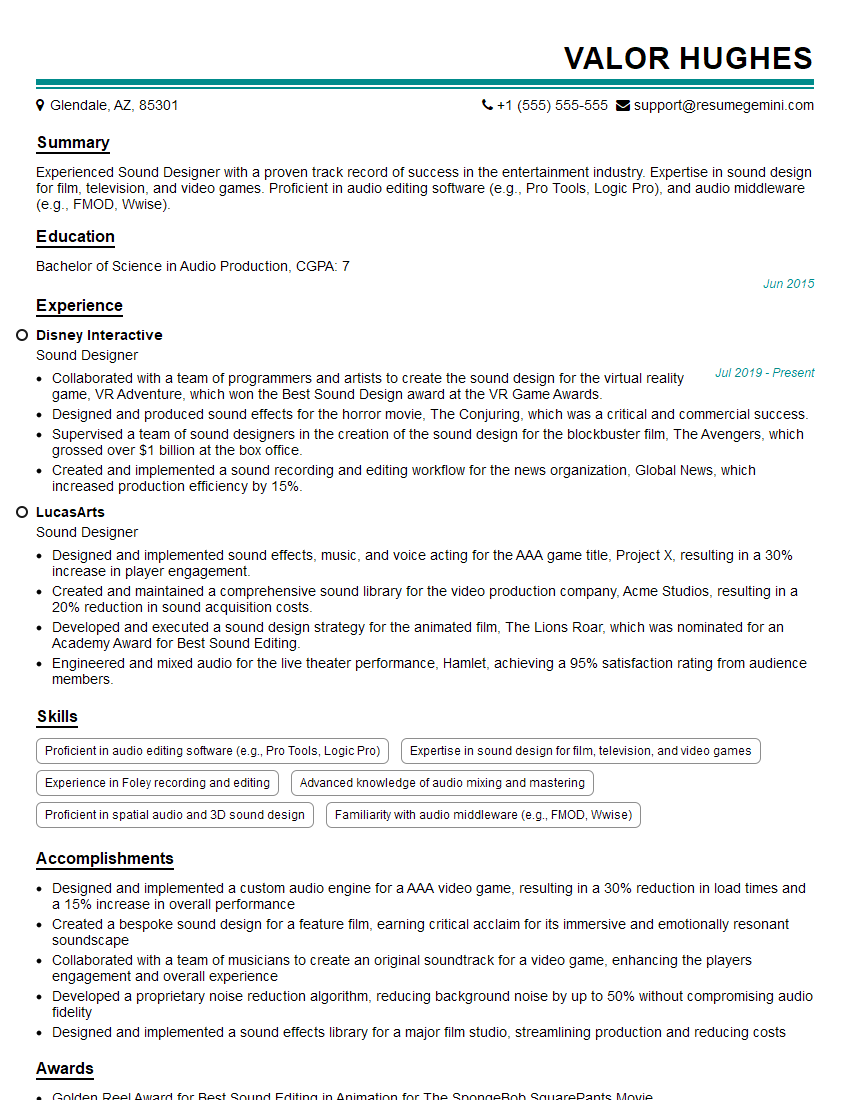Interviews are more than just a Q&A session—they’re a chance to prove your worth. This blog dives into essential Shure ULX-D Wireless Systems interview questions and expert tips to help you align your answers with what hiring managers are looking for. Start preparing to shine!
Questions Asked in Shure ULX-D Wireless Systems Interview
Q 1. Explain the frequency hopping technology in Shure ULX-D.
Shure ULX-D utilizes Frequency Hopping Spread Spectrum (FHSS) technology to enhance wireless signal reliability and reduce interference. Instead of transmitting on a single frequency, it rapidly switches between multiple frequencies within a pre-defined bandwidth. Think of it like a constantly changing radio station – if one frequency gets crowded or interfered with, the system instantly jumps to a clearer channel, maintaining a consistent signal.
This hopping pattern is unique to each transmitter and receiver pair, and is managed by the system’s sophisticated algorithms. This makes it significantly more resilient to interference than systems using a single, fixed frequency.
This is particularly beneficial in environments with numerous wireless devices, such as large concerts or broadcast studios, where interference from other wireless microphones, Wi-Fi routers, or other RF sources is common.
Q 2. Describe the difference between High Density and Standard mode in ULX-D.
The difference between High Density and Standard mode in ULX-D lies in the number of channels available and the spacing between them. Standard mode offers a wider spacing between frequencies, resulting in fewer channels but with increased immunity to interference. It’s ideal for simpler setups where interference is less of a concern.
High Density mode, on the other hand, crams more channels into the same frequency range by using narrower spacing. This allows for many more simultaneous wireless microphone systems to operate within the same area, but at the cost of slightly reduced interference immunity. It’s perfect for large-scale productions requiring numerous wireless mics where channel availability is paramount.
Choosing between the two depends heavily on the specific needs of your event. If you need to run a large number of wireless mics, High Density might be necessary, accepting the slightly increased vulnerability to interference. In less crowded RF environments, Standard mode offers better reliability.
Q 3. How do you manage RF interference in a dense RF environment using ULX-D?
Managing RF interference in dense RF environments with ULX-D requires a multi-faceted approach. First, perform a thorough frequency scan using the ULX-D’s built-in scanning functionality to identify clear frequencies with minimal interference. The system will suggest the cleanest channels available.
Second, utilize High Density mode if necessary, but be aware of the trade-off in interference immunity. Carefully plan channel assignments to minimize adjacent channel interference. Consider using directional antennas on the receivers to further improve signal quality and reduce the reception of unwanted signals. Also, check for sources of interference: Wi-Fi networks, cellular devices, and other wireless systems can all create significant problems.
Third, if interference persists, consider using advanced features such as the ULX-D’s high-gain antennas or external antennas to improve signal reception and reduce the impact of interference. Finally, proper cable management and antenna placement are crucial for optimal performance.
In extreme cases where interference is unavoidable, exploring alternative frequency ranges or adjusting the setup might be necessary.
Q 4. What are the key features of the Shure ULX-D receiver?
The Shure ULX-D receiver boasts several key features designed for professional-grade performance and ease of use. These include:
- Wide Frequency Range: Access to a large number of frequencies, ensuring flexibility in various RF environments.
- High-Quality Audio: Provides crystal-clear, low-noise audio reproduction.
- Digital Signal Processing (DSP): Offers features such as high dynamic range, excellent rejection of interference and high-quality audio.
- Frequency Agility: The ability to quickly switch frequencies to optimize performance.
- High RF Sensitivity: Enhances the receiver’s ability to pick up weak signals.
- Network Connectivity: Allows for remote monitoring and control via Shure’s Wireless Workbench software.
- LCD Display: Provides clear and concise information on frequency, RF level, and audio status.
- Multiple Antenna Options: Supports diverse antenna configurations to optimize performance depending on your environment.
These features, combined with its rugged construction, make the ULX-D receiver a reliable and powerful choice for demanding professional applications.
Q 5. Explain the process of setting up a Shure ULX-D wireless system.
Setting up a Shure ULX-D wireless system involves several steps:
- Frequency Scan: Begin by performing a frequency scan to identify available, clean channels with minimal interference.
- Channel Selection: Select the appropriate channels based on the scan results and available frequencies.
- Transmitter Setup: Configure the transmitter to the selected channel and desired settings (e.g., microphone gain, transmit power).
- Receiver Setup: Set up the receiver to match the transmitter’s channel. This usually involves selecting the same group and channel on both units.
- Pairing: Pair the transmitter and receiver; the specific method will depend slightly on the system’s generation.
- Antenna Placement: Strategically place antennas for optimal coverage and signal strength, avoiding metal and other obstructions.
- Testing: Thoroughly test the system in the intended environment to ensure proper functionality and audio quality.
- Monitoring: Regularly monitor the RF signal strength during operation to promptly identify and resolve any interference issues.
Shure’s Wireless Workbench software is extremely helpful for managing larger systems and monitoring multiple devices remotely.
Q 6. How do you pair a Shure ULX-D transmitter to a receiver?
Pairing a Shure ULX-D transmitter to a receiver is typically a straightforward process. First, ensure both the transmitter and receiver are powered on and set to the same frequency group and channel.
Usually, a pairing button is located on both devices. Simultaneously, press and hold the pairing buttons on both the transmitter and the receiver until the pairing is confirmed by indicators on the devices (usually an LED light changing color). Once the pairing is complete, the transmitter’s audio should be heard through the receiver.
The precise pairing procedure might differ slightly depending on the exact model of the ULX-D system and sometimes involves a setup menu within the receiver. Refer to the specific user manual for the most accurate instructions.
Q 7. How do you perform a frequency scan with Shure ULX-D?
Performing a frequency scan with Shure ULX-D is crucial for optimizing performance and mitigating interference. The process is usually initiated through the receiver’s menu interface.
Generally, you navigate to the receiver’s setup menu and select the option to perform a frequency scan. The system will then automatically search across the available frequency range, assessing signal strength and interference levels. This process may take several seconds to a few minutes, depending on the system’s capabilities and complexity of the RF environment.
Once the scan is complete, the receiver will present a list of available frequencies, ranked by signal quality. You can then select the frequencies with the strongest signal and the least amount of interference for your transmitters.
Shure’s Wireless Workbench software provides an even more comprehensive and visually intuitive means of performing frequency scans, especially beneficial in large-scale applications with numerous wireless systems.
Q 8. Explain the function of the squelch settings on the ULX-D receiver.
The squelch setting on a Shure ULX-D receiver controls the receiver’s sensitivity to incoming RF signals. Think of it as a gatekeeper for your audio. It prevents unwanted noise from being amplified when no transmitter signal is present. If the received signal strength falls below the squelch threshold, the receiver mutes the audio output, preventing hiss or other background interference.
The squelch is adjustable, allowing you to fine-tune the sensitivity. A setting that’s too high might cause audio dropouts when the signal is weak, while a setting that’s too low might let in unwanted noise. The ideal setting balances minimizing noise with ensuring reliable signal reception. You’ll typically find the squelch adjustment as a knob or digital control on the receiver, often labeled ‘Squelch’ or with a similar icon.
For example, in a live concert, a higher squelch setting might be preferable to avoid background hiss, even if it means a slightly increased risk of a momentary dropout during quick performer movements. Conversely, in a presentation, a lower squelch setting might be more suitable to ensure consistent audio, accepting a slightly higher background noise floor.
Q 9. Describe different antenna options for Shure ULX-D and their applications.
Shure ULX-D systems offer a variety of antenna options to optimize RF performance based on the environment and the scale of your operation. The choice depends on factors like the size of the venue, the presence of RF interference, and the number of channels you’re using.
- Half-wave dipoles: These are the most common antennas and provide a good balance of performance and convenience. They are relatively inexpensive and are suitable for many applications.
- Passive combination antennas: These antennas combine multiple antenna elements into a single unit. They’re useful for multi-channel systems and can help minimize interference between channels.
- Active antennas: Active antennas include an amplifier, improving the signal-to-noise ratio and expanding the range. They are helpful in challenging RF environments with lots of interference or when long distances are involved.
- Directional antennas: These antennas focus the signal in a specific direction, enhancing range and reducing interference. They’re beneficial in scenarios where you have line-of-sight limitations or significant RF noise from a specific source.
For instance, a small theatre might only need a couple of half-wave dipoles, while a large stadium might require multiple active antennas strategically placed for optimal coverage.
Q 10. What are the benefits of using Shure ULX-D over other wireless systems?
Shure ULX-D offers several advantages over other wireless systems. Its high-end features provide reliability and professional-grade performance.
- High-quality audio: ULX-D provides exceptional audio fidelity with minimal artifacts, ensuring a clean and natural sound.
- Robust RF performance: The system’s advanced digital processing minimizes dropouts and interference, making it ideal for challenging RF environments.
- Wide frequency range and channel selection: The ULX-D’s extensive frequency range offers more channel options, making it easier to coordinate frequencies with other wireless systems.
- High-quality build: The durable design ensures longevity and reliable operation.
- Comprehensive management software: Shure’s Wireless Workbench software provides advanced control and monitoring of the entire wireless system, simplifying frequency coordination and troubleshooting.
For example, a broadcast studio needing pristine, interference-free audio would significantly benefit from the ULX-D’s superior RF performance and audio quality compared to a consumer-grade system. The ability to manage multiple channels easily via Wireless Workbench is also a major advantage for larger productions.
Q 11. How do you troubleshoot audio dropouts in a Shure ULX-D system?
Troubleshooting audio dropouts in a Shure ULX-D system involves a systematic approach to identify the cause. Begin by considering several key areas:
- Check antenna connections: Ensure all antenna cables are securely connected to both the antennas and the receiver. Loose connections are a common source of dropouts.
- Examine the RF meter: Observe the RF meter on the receiver. Low signal strength indicates a weak connection or interference. Adjust antenna placement or select a clearer frequency if necessary.
- Inspect the transmitter battery: Low transmitter battery power can also cause intermittent dropouts. Replace the batteries or recharge them.
- Verify frequency coordination: Ensure the transmitter and receiver are set to the same frequency and channel. Interference from other wireless devices can also cause dropouts. Use Wireless Workbench to scan the RF spectrum for interference and adjust frequencies accordingly.
- Check for interference sources: Identify and mitigate potential interference sources such as other wireless devices, metal objects, or sources of electromagnetic interference.
- Inspect cables and connectors: Check for any damage to audio cables and connections between the receiver and the audio equipment.
If the problem persists, contact Shure support for further assistance.
Q 12. How do you manage power and battery life in Shure ULX-D systems?
Managing power and battery life in ULX-D systems involves selecting appropriate batteries and employing good operational practices. ULX-D transmitters use rechargeable lithium-ion batteries. The specific battery life depends on the type of battery used and its capacity.
- Use high-capacity batteries: Choosing batteries with a higher milliampere-hour (mAh) rating will extend operating time significantly.
- Monitor battery level: Regularly check the battery level indicator on the transmitter to avoid unexpected power failures. Many systems provide low battery warnings.
- Recharge batteries regularly: Follow the manufacturer’s recommendations for charging time and cycles to maintain optimum battery performance and lifespan.
- Use battery management software (if available): Some Shure systems offer software to monitor and manage battery charge levels for multiple transmitters.
- Power down transmitters when not in use: This is a simple yet effective way to preserve battery life.
For instance, in a multi-day event, having multiple sets of fully charged batteries or employing battery charging stations is essential to ensure uninterrupted operation.
Q 13. Explain the importance of proper antenna placement for Shure ULX-D.
Proper antenna placement is crucial for maximizing signal strength and minimizing interference in Shure ULX-D systems. Poor antenna placement can lead to reduced range, dropouts, and increased susceptibility to interference from other wireless devices.
- Maintain line of sight: Whenever possible, place antennas in locations with clear line-of-sight to the transmitters. Obstructions like walls, metal objects, and people can significantly attenuate the signal.
- Elevate antennas: Raising the antennas higher than potential interference sources improves signal strength. The higher the better, but the placement should also be practical and safe.
- Separate antennas from interference sources: Keep antennas away from potential sources of RF interference such as computers, lighting equipment, and other wireless devices. Adequate spacing minimizes the likelihood of interference.
- Use multiple antennas: In large venues, using multiple antennas provides better coverage and redundancy. This can help minimize dropouts caused by signal fading or interference.
- Consider antenna diversity: Using two antennas of the same type and carefully spacing them improves signal quality. If one antenna experiences interference, the other can provide a stronger signal.
Imagine setting up a wireless microphone system for a large conference hall. Poor antenna placement could result in significant audio dropouts in certain areas of the hall, making the system unusable. Strategic antenna placement, utilizing multiple antennas and taking into account potential interference sources, ensures reliable and consistent audio quality throughout the entire venue.
Q 14. Describe how to interpret the RF meter on the Shure ULX-D receiver.
The RF meter on a Shure ULX-D receiver provides a visual representation of the received signal strength. It is an essential tool for troubleshooting and optimizing wireless system performance. The meter typically displays a range of signal strength levels, usually represented by LEDs or a numerical display.
A strong signal will typically illuminate most or all of the LEDs or indicate a high numerical value, suggesting a good connection and minimal interference. A weak signal, indicated by a few illuminated LEDs or a low value, suggests that interference or distance from the transmitter may be affecting the signal. This could be caused by obstacles between the transmitter and receiver, interference from other devices, or a low transmitter battery.
Ideally, you want a consistently strong, stable signal during operation. A fluctuating or inconsistent signal strength often points to a problem with the system, such as antenna placement, frequency interference, or transmitter issues. Using the RF meter as part of your workflow enables proactive adjustments to ensure reliable audio transmission.
Q 15. What are the common causes of RF interference with Shure ULX-D?
RF interference in Shure ULX-D systems, like any wireless microphone system, stems from other devices operating on the same or adjacent frequencies. Think of it like a crowded radio station – if too many stations broadcast on the same frequency, you’ll get static. Common culprits include other wireless microphones, Wi-Fi routers, cellular phones, and even some dimmer switches. The closer these interfering devices are to your ULX-D receivers, the more severe the interference will be.
- Other Wireless Systems: The most common cause. Using multiple wireless systems without proper frequency coordination can lead to signal dropouts and audio artifacts.
- Wi-Fi and Bluetooth Devices: These operate in the 2.4 GHz band, which overlaps with some ULX-D frequency ranges. A strong Wi-Fi signal near your receivers can significantly impact performance.
- Cellular Networks: Certain cellular frequencies can interfere, especially in areas with high cellular traffic.
- Dimmer Switches and Other Electronic Devices: Older dimmer switches and some industrial equipment can generate RF noise that affects wireless microphones.
Identifying the source often requires careful observation and systematic elimination. Using a spectrum analyzer can pinpoint the interfering frequencies.
Career Expert Tips:
- Ace those interviews! Prepare effectively by reviewing the Top 50 Most Common Interview Questions on ResumeGemini.
- Navigate your job search with confidence! Explore a wide range of Career Tips on ResumeGemini. Learn about common challenges and recommendations to overcome them.
- Craft the perfect resume! Master the Art of Resume Writing with ResumeGemini’s guide. Showcase your unique qualifications and achievements effectively.
- Don’t miss out on holiday savings! Build your dream resume with ResumeGemini’s ATS optimized templates.
Q 16. How do you use the Shure Wireless Workbench software with ULX-D?
Shure Wireless Workbench (WWB) is a powerful software application that allows comprehensive control and monitoring of your ULX-D system. It’s like having a central command center for your wireless microphones. You can use it to:
- Scan for available frequencies: WWB analyzes the RF environment and suggests optimal frequencies for your transmitters, minimizing the risk of interference.
- Manage frequencies: Assign frequencies to your transmitters, ensuring they don’t clash with each other or other wireless devices.
- Monitor transmitter status: Real-time monitoring of battery levels, RF signal strength, and audio levels is displayed, allowing for proactive problem-solving.
- Firmware updates: Keep your system up-to-date with the latest firmware to ensure optimal performance and access new features.
- Remote control: Control various aspects of the system remotely from a computer, useful in larger venues or complex setups.
Connecting WWB is straightforward: You’ll need a compatible computer, a network cable (usually Ethernet), and potentially an appropriate USB-to-Ethernet adapter. The detailed instructions can be found in the Shure WWB manual. Once connected, WWB automatically detects your ULX-D receivers. Imagine it as a sophisticated dashboard that gives you total control and insight into every aspect of your wireless system’s performance.
Q 17. Explain the concept of frequency coordination in wireless microphone systems.
Frequency coordination is crucial for avoiding interference in wireless microphone systems. It involves strategically selecting frequencies for each transmitter to ensure they don’t overlap or clash. Think of it like assigning different radio channels to different radio stations; you wouldn’t want them all broadcasting on the same frequency at the same time!
The process typically involves using a spectrum analyzer or frequency coordination software (like Shure Wireless Workbench) to identify available, clean frequencies in your RF environment. This is especially critical in environments with many wireless devices operating concurrently, such as large conferences, theaters, or stadiums. Proper coordination prevents signal dropouts, audio artifacts (like crackling or static), and ensures reliable audio transmission. This process is often done prior to the event and can greatly reduce technical issues and save time during setup.
Consider a scenario where several bands are performing at a music festival. Without proper frequency coordination, their wireless mics could interfere with each other, leading to audio problems during their performances. Effective coordination ensures each band’s audio is clear and interference-free.
Q 18. How do you perform routine maintenance on Shure ULX-D equipment?
Routine maintenance for Shure ULX-D equipment is vital for long-term performance and reliability. It’s a preventative approach that saves you from costly repairs down the road.
- Regularly inspect cables and connectors: Check for any damage, wear, or loose connections. Replace any damaged cables immediately.
- Clean the equipment: Use a soft, slightly damp cloth to gently wipe away dust and debris from the transmitters, receivers, and antennas. Avoid using harsh chemicals.
- Check battery health: For bodypack transmitters, regularly inspect and replace batteries as needed. Monitor battery levels during events using Shure Wireless Workbench.
- Firmware updates: Stay up-to-date with the latest firmware. These updates often include bug fixes and performance improvements. Check Shure’s website for the latest releases.
- Periodic testing: Regularly test the entire system to ensure all components are functioning correctly. Check signal strength and audio quality in various locations.
Think of it like maintaining your car – regular maintenance prevents major breakdowns. With consistent care, your ULX-D system will provide years of reliable performance.
Q 19. Describe the different types of antennas used with Shure ULX-D.
Shure ULX-D systems utilize a variety of antennas depending on the specific needs of the application. The choice of antenna significantly impacts the range and reliability of your wireless signal.
- Half-wave dipole antennas: These are common, providing good performance in relatively simple environments. They’re often part of the receiver chassis.
- Directional antennas: These antennas focus the signal in a specific direction, useful for maximizing range in a particular area and reducing interference. They can be used for both transmitters and receivers.
- Panel antennas: These are often used for distributing signals in a large area. Typically found on receiver units.
- Passive combiners: These combine signals from multiple antennas into a single output, increasing signal diversity and reliability.
Selecting the right antenna is crucial. A directional antenna might be perfect for a large outdoor concert, while half-wave dipoles might suffice for a small studio. The environment and the range you need determine the best antenna choice. The Shure ULXD4 receiver uses a diversity antenna, meaning that it combines signals from two antennas to optimize signal strength and reliability.
Q 20. What is the difference between the ULXD1, ULXD2, and ULXD4 transmitters?
The ULXD1, ULXD2, and ULXD4 transmitters in the Shure ULX-D system represent different form factors tailored to specific applications. The key differences lie in their size, power source, and intended use.
- ULXD1: This is a handheld transmitter, perfect for vocalists. It’s robust, features a high-quality microphone element, and typically uses rechargeable batteries.
- ULXD2: This is a bodypack transmitter, designed to be worn by performers. It’s compact and lightweight, making it comfortable for extended use. It can accommodate various microphone and instrument inputs. Power can be achieved via an AA battery or rechargeable options.
- ULXD4: This is a quad receiver which combines the power of four individual channels into a single unit, suitable for installations needing multiple independent wireless audio feeds simultaneously. It offers superior management and monitoring capabilities and uses a diversity antenna array for superior signal reliability.
Think of them as different tools for different jobs – the handheld for vocalists, the bodypack for instrument players and presenters, and the quad receiver for large-scale installations. The choice depends entirely on your specific needs.
Q 21. How do you troubleshoot a transmitter that is not powering on?
Troubleshooting a Shure ULX-D transmitter that won’t power on requires a systematic approach.
- Check the batteries: For bodypack transmitters (ULXD2), make sure the batteries are fresh and correctly installed. For handheld transmitters (ULXD1), ensure the rechargeable battery is fully charged. This is the most common cause of power failure.
- Examine the power switch: Ensure that the power switch on the transmitter is in the ‘on’ position. Sometimes a simple oversight can be the culprit.
- Inspect the antenna connection: A loose or damaged antenna connection can prevent the transmitter from powering up. Try tightening the connection or replacing the antenna if it’s damaged.
- Verify the transmitter’s RF channel is selected: Ensure the frequency is appropriately chosen in conjunction with the receiver’s setup to prevent issues arising from channel incompatibility.
- Check for physical damage: Look closely for any signs of damage to the transmitter, such as cracks or dents. Water damage can also prevent a transmitter from powering on.
- Test with a known good battery/power source: This can isolate whether the issue is with the transmitter itself or the power source.
- Try a different receiver: If you’ve ruled out other issues, test the transmitter with a known good receiver. This will help you isolate whether the fault lies with the transmitter or receiver.
If none of these steps resolve the issue, contact Shure support or your authorized dealer for repair or replacement.
Q 22. How do you handle a situation where multiple wireless systems are interfering with each other?
Interference in multi-wireless system setups is a common challenge. The Shure ULX-D system, while robust, requires careful frequency coordination. The key is proactive frequency management. First, I would use Shure’s Wireless Workbench software (WWB) to scan the RF environment and identify available, clean frequencies. WWB provides a visual representation of occupied and available frequencies, allowing for intelligent channel selection. This minimizes interference before the event even begins. If interference occurs during a live event, I’d first try adjusting the system’s transmit power. Reducing power can improve performance, but reduces range. If the problem persists, I’d try switching to an alternative frequency, again consulting WWB for options. Lastly, physical antenna placement plays a crucial role. For example, ensuring adequate distance between antennas, using directional antennas to minimize signal overlap, and placing antennas away from metal objects or other sources of interference can drastically improve performance. In a pinch, a temporary solution might involve strategically powering down less critical wireless units temporarily to free up spectrum.
Q 23. What are the different audio output options available on the ULX-D receiver?
The Shure ULX-D receiver offers a variety of audio output options, catering to diverse system setups. It provides balanced XLR outputs – the industry standard for professional audio – providing a high-quality connection to mixers and other audio equipment. It also features a balanced 1/4-inch output, offering flexibility for integration with different equipment. Finally, it’s also possible to use the AES/EBU digital audio output for high-fidelity digital audio transmission, especially beneficial in larger installations where digital workflows are preferred. Choosing the right output depends on the rest of your audio infrastructure; however, the XLR is generally the preferred output for its reliability and professional compatibility.
Q 24. Explain the use of the group and channel settings in Shure ULX-D.
Group and channel settings in the ULX-D system are crucial for managing multiple wireless units efficiently. They function like a two-tiered system. ‘Groups’ are broader frequency bands that help to divide your wireless system into manageable segments. Imagine it like dividing a large orchestra into sections – strings, brass, woodwinds, etc. This helps to reduce the chance of interference between different sections of your wireless system. Each ‘Group’ might contain multiple ‘Channels’. ‘Channels’ are specific frequencies within the group. Each individual wireless microphone or transmitter occupies a unique channel within its assigned group. For instance, you might assign all the lavalier microphones to Group A with unique channels (A1, A2, A3) and all the handheld microphones to Group B (B1, B2, B3). This ensures that even if you have a lot of wireless mics, they are organized, and the chances of interference are minimized. Careful planning of groups and channels is essential for avoiding problems, especially in environments with many wireless systems operating.
Q 25. How would you troubleshoot audio distortion in a Shure ULX-D system?
Troubleshooting audio distortion in a ULX-D system requires a systematic approach. First, I’d check the transmitter’s gain and make sure it isn’t set too high, leading to clipping. I’d then examine the receiver’s audio levels, ensuring it isn’t overloaded. Next, I would check the RF signal strength using the receiver’s metering. A weak signal can cause distortion. I’d also inspect the antenna placement and cables, making sure there’s no damage or poor connections. Environmental factors such as interference from other wireless systems, or even sources like fluorescent lights, can also cause distortion. This might necessitate a frequency scan using Shure Wireless Workbench to identify and remedy interference. If the problem persists, a close inspection of the battery would be crucial; a faulty or low battery can manifest as audio distortion. A final check would involve testing the microphone itself with a wired connection to rule out a problem with the microphone capsule. Following these steps logically allows for a quick identification of the root cause of the distortion.
Q 26. Describe the features of the Shure ULX-D’s rechargeable battery system.
The Shure ULX-D system uses a rechargeable lithium-ion battery system. One of its significant advantages is extended run time. The SB900A battery provides considerably long operating hours, minimizing interruptions. Beyond run time, the system allows for convenient charging, with the SB900A battery being easily swapped. This allows for uninterrupted operation. Shure also provides charging solutions, including single-bay and multi-bay chargers, for efficient management of multiple batteries. The batteries also have an informative status display, showing remaining power on the battery and the receiver. This lets you know when a battery needs replacing before the event begins. The combination of long battery life, easy swapping, and efficient charging makes the ULX-D system ideal for long events and situations requiring continuous operation.
Q 27. How do you perform a quick system check before a live event using Shure ULX-D?
A quick system check before a live event is crucial. First, I’d power up all the transmitters and receivers, checking for any error messages on the receiver’s screen. Then, I’d carefully go through each channel, checking the RF signal strength. Weak signals indicate potential problems and should be addressed by optimizing antenna placement or changing frequencies. Next, I’d verify audio levels by speaking into each transmitter, monitoring the receiver’s audio meters. I’d also check the battery levels of each transmitter, and if using them, the charging station to ensure the batteries are fully charged and ready to go. Finally, I’d perform a quick audio check through the entire signal chain. This ensures that everything from the microphone through to the mixing console is functioning properly and there is no unexpected noise or distortion. If everything looks good on the receivers, a final check of the audio mix to ensure all microphones are audible and appropriately balanced is the last step. This systematic approach ensures a smooth event start.
Key Topics to Learn for Shure ULX-D Wireless Systems Interview
- System Architecture: Understanding the transmitter, receiver, and antenna components and their interaction within the ULX-D system. Consider frequency agility and diversity reception.
- Frequency Coordination & Management: Practical application of channel scanning, setting up frequency coordination for multi-channel setups, and troubleshooting interference issues. Explore spectrum management best practices.
- Audio Signal Path: Analyze the journey of the audio signal from the microphone to the mixer, understanding gain staging, RF signal strength, and potential sources of audio degradation.
- Wireless Transmission Principles: Grasp the basics of RF transmission, including frequency response, bandwidth, and the factors affecting signal quality (e.g., distance, obstacles).
- Troubleshooting and Maintenance: Develop problem-solving skills to diagnose common issues like signal dropouts, interference, and low battery warnings. Understand preventative maintenance procedures.
- Software and Control: Familiarity with the Shure Wireless Workbench software for system management, monitoring, and configuration. Explore different control options and their applications.
- Different Microphone Compatibility: Understand the various microphone options compatible with the ULX-D system and the implications for different applications (e.g., handheld, lavalier, instrument).
- Advanced Features: Explore advanced features such as High Density mode, network capabilities, and AES-256 encryption (if applicable to the specific ULX-D model).
Next Steps
Mastering Shure ULX-D Wireless Systems demonstrates valuable technical skills highly sought after in audio engineering, live sound, and broadcast industries. This knowledge significantly enhances your career prospects and opens doors to exciting opportunities. To maximize your chances of securing your dream role, it’s crucial to present your skills effectively. Building an ATS-friendly resume is essential for getting your application noticed. We recommend using ResumeGemini, a trusted resource for creating professional and impactful resumes. Examples of resumes tailored to highlight Shure ULX-D Wireless Systems expertise are available for your reference.
Explore more articles
Users Rating of Our Blogs
Share Your Experience
We value your feedback! Please rate our content and share your thoughts (optional).
What Readers Say About Our Blog
Take a look at this stunning 2-bedroom apartment perfectly situated NYC’s coveted Hudson Yards!
https://bit.ly/Lovely2BedsApartmentHudsonYards
Live Rent Free!
https://bit.ly/LiveRentFREE
Interesting Article, I liked the depth of knowledge you’ve shared.
Helpful, thanks for sharing.
Hi, I represent a social media marketing agency and liked your blog
Hi, I represent an SEO company that specialises in getting you AI citations and higher rankings on Google. I’d like to offer you a 100% free SEO audit for your website. Would you be interested?

